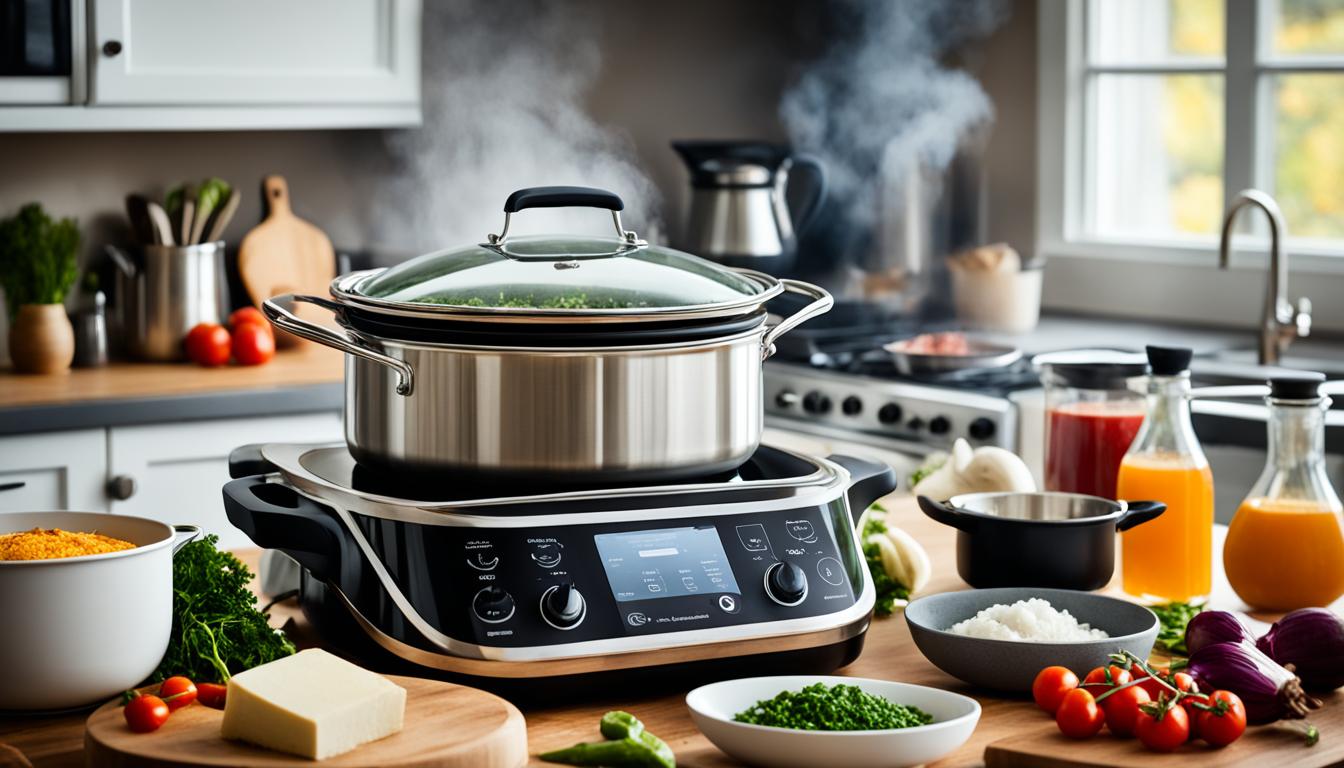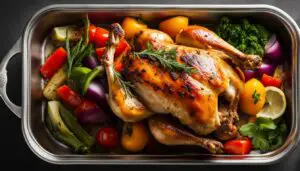Originally posted on April 6, 2024 @ 7:03 am
Did you know that nearly 83% of households in the United States own a slow cooker? That’s a staggering number of people enjoying the convenience and deliciousness of slow-cooked meals. But what if you find yourself without a slow cooker or needing to cook a slow cooker recipe faster? That’s where stovetop adaptation comes in. In this comprehensive guide, we’ll show you how to seamlessly transition your favorite slow cooker recipes to the stovetop, allowing you to still savor the flavors and convenience of these dishes. Whether you’re short on time, don’t own a slow cooker, or simply prefer stovetop cooking, we’ve got you covered.
Contents
- 1 Why Adapt Slow Cooker Recipes for the Stovetop?
- 2 Converting Slow Cooker Recipes to Stovetop: General Guide
- 3 Tips for Successful Stovetop Adaptation
- 4 How to Adjust Cooking Time for Stovetop Adaptation
- 5 Safety Tips for Stovetop Adaptation
- 6 The Versatility of Slow Cooker Recipes
- 7 Personal Experiences with Stovetop Adaptation
- 8 Discover More Slow Cooker Tips and Recipes
- 9 Helpful Tools for Stovetop Adaptation
- 10 Conclusion
- 11 FAQ
- 11.1 Can I use slow cooker recipes on the stove?
- 11.2 How do I convert slow cooker recipes to stovetop cooking?
- 11.3 What tips can help me successfully adapt slow cooker recipes for the stovetop?
- 11.4 How do I adjust the cooking time when adapting slow cooker recipes for the stovetop?
- 11.5 What safety precautions should I take when adapting slow cooker recipes for the stovetop?
- 11.6 What types of recipes can I make in a slow cooker?
- 11.7 Are there any personal experiences with stovetop adaptation?
- 11.8 Where can I find more slow cooker tips and recipes?
- 11.9 What tools can assist with stovetop adaptation?
- 11.10 Is adapting slow cooker recipes for stovetop cooking a practical and convenient method?
- 12 Source Links
Key Takeaways:
- Stovetop adaptation allows you to cook slow cooker recipes without a slow cooker.
- Adapting slow cooker recipes to the stovetop provides flexibility and convenience.
- With the right techniques and adjustments, you can achieve delicious results on the stovetop.
- Stovetop adaptation is a great option for those who prefer faster cooking or don’t own a slow cooker.
- Follow the safety tips and adjust cooking times properly for successful stovetop adaptation.
Why Adapt Slow Cooker Recipes for the Stovetop?
While slow cookers offer convenience and ease, there are times when you may need to adapt a recipe for stovetop cooking. This could be due to time constraints, not having a slow cooker on hand, or simply personal preferences. Adapting slow cooker recipes for the stovetop allows you to still enjoy the delicious flavors and convenience of these dishes without relying on a slow cooker.
Stovetop cooking offers a quicker alternative to slow cooking, making it ideal for busy households or when you’re craving a particular dish but don’t have hours to spare. By adapting slow cooker recipes, you can adjust the cooking method to match your schedule and still achieve mouthwatering results.
Furthermore, stovetop cooking allows for greater control and versatility in terms of heat levels, stirring, and adjusting flavors as you go along. You can easily taste and make adjustments to the recipe to suit your preferences, ensuring a perfectly tailored dish every time.
Whether you’re a proficient cook or just starting your culinary journey, adapting slow cooker recipes for the stovetop is a valuable skill to have. It opens up a world of possibilities, enabling you to experiment with different cooking methods and techniques while still enjoying the comforting and flavorful dishes that slow cookers are known for.
“Adapting slow cooker recipes for stovetop cooking allows you to have greater control, adjust flavors according to your taste, and enjoy the convenience of shorter cooking times.” – Chef Lisa Thompson
So, if you find yourself without a slow cooker or simply prefer the stovetop method, don’t worry! With a few adjustments and some creativity, you can adapt your favorite slow cooker recipes to suit your cooking style and still indulge in the delightful flavors you love.
Converting Slow Cooker Recipes to Stovetop: General Guide
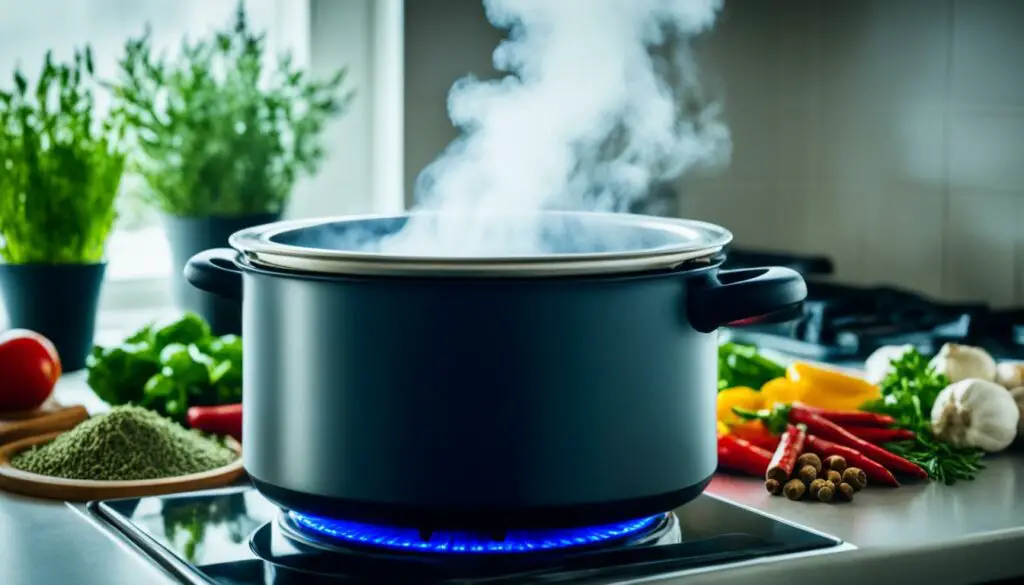
Converting your favorite slow cooker recipes for stovetop cooking can be easily done with a few adjustments. Whether you’re craving a hearty soup, succulent roast, or comforting casserole, this general guide will help you seamlessly adapt your slow cooker recipes for stovetop preparation.
Adjustments for Converting Slow Cooker Recipes
When converting slow cooker recipes to stovetop cooking, it’s important to make a few key adjustments. While the slow cooker relies on low and slow heat, stovetop cooking involves higher temperatures and shorter cooking times. Here are some general guidelines to follow:
- Reduce cooking time: Since stovetop cooking is faster, you’ll need to reduce the cooking time. Start by checking the recipe’s suggested cooking time and then reduce it by approximately 25-30%. However, keep in mind that cooking times may vary based on the specific recipe and ingredients, so it’s essential to monitor the dish closely.
- Adjust heat: Slow cookers often use low or high heat settings. For stovetop conversion, adjust the heat to medium-low or medium-high, depending on the recipe’s original cooking setting. This will help maintain a steady simmer or gentle boil.
- Use a meat thermometer: To ensure proper cooking and food safety, it’s crucial to use a meat thermometer to check the internal temperature of any meat or poultry. Follow the recommended internal temperature guidelines to achieve safe and perfectly cooked dishes.
- Taste test and season: Since stovetop cooking happens at higher temperatures, the flavors can intensify. Taste test your dish as it cooks and adjust seasonings accordingly. Be mindful of any additional salt or spices you may need to add.
General Guide for Converting Slow Cooker Recipes by Type
| Slow Cooker Recipe Type | Conversion Guidelines |
|---|---|
| Soups and Stews | Reduce the cooking time and simmer on the stovetop until flavors meld and ingredients are cooked to desired tenderness. |
| Roasts and Braised Meats | Sear the meat on the stovetop, then transfer it to a covered pot or Dutch oven. Simmer over low heat until the meat is tender. |
| Casseroles and One-Pot Meals | Follow the recipe’s instructions for layering ingredients. Simmer on the stovetop until all components are cooked through and flavors have melded. |
Remember, this is just a general guide, and each recipe may require specific adjustments based on the ingredients and cooking method. Use your discretion, taste as you go, and don’t hesitate to experiment with different techniques to achieve the best results.
Tips for Successful Stovetop Adaptation
When it comes to successfully adapting slow cooker recipes for stovetop cooking, a few key tips can make all the difference. From defrosting ingredients to adjusting liquid quantities, here are some essential tips to help you achieve flavorful results using the slow cooker to stove method.
1. Defrost Ingredients
Before starting the stovetop adaptation, be sure to properly defrost any frozen ingredients. Thawing ingredients in advance will ensure even cooking and prevent uneven textures in your dish.
2. Adjust Liquid Quantities
When moving a slow cooker recipe to the stovetop, you may need to adjust the liquid quantities. Slow cookers generate moisture during the long cooking process, while stovetop cooking requires a different amount of liquid. Keep an eye on the consistency of the dish and add more liquid if needed to prevent it from drying out.
3. Alter Herbs and Spices
Herbs and spices can behave differently during stovetop cooking compared to slow cooking. To ensure well-balanced flavors, consider altering the amounts or timing of herbs and spices. Taste and adjust seasonings as needed throughout the cooking process.
4. Correct Placement of Ingredients
The placement of ingredients in the pot can affect the cooking process and flavor distribution. Place tougher ingredients, such as root vegetables or meat, at the bottom to ensure they cook evenly. Delicate ingredients, like herbs or dairy products, are best added towards the end to preserve their freshness and flavors.
5. Thicken Sauces
If you find that your sauce or gravy needs thickening, there are several methods you can use. One option is to mix a small amount of cornstarch with water and gradually add it to the dish, stirring constantly until it reaches the desired consistency. Alternatively, you can create a rue by melting butter, adding flour, and cooking it briefly before adding it to the sauce.
6. Take Notes for Future Reference
Adapting slow cooker recipes to the stovetop is a learning process. To ensure consistency and future success, take notes on adjustments made, cooking times, and any other changes. These notes will serve as a valuable reference for future adaptations and modifications.
By following these tips, you can confidently adapt your favorite slow cooker recipes to the stovetop, creating delicious meals with the slow cooker to stove method.
How to Adjust Cooking Time for Stovetop Adaptation
When it comes to adapting slow cooker recipes for stovetop cooking, one crucial aspect to consider is adjusting the cooking time. Since stovetop cooking typically offers higher heat and a faster cooking process compared to slow cookers, managing the cooking time is essential to achieve perfectly cooked dishes.
To help you navigate this adjustment, refer to the handy chart below that outlines the conversion of cooking times from stovetop or oven settings to slow cooker settings. This chart serves as a valuable reference tool to ensure your stovetop adaptation goes smoothly and delivers delicious results.
| Stovetop or Oven Cooking Time | Slow Cooker Cooking Time |
|---|---|
| 30 minutes | 4-6 hours on Low or 2-3 hours on High |
| 1 hour | 6-8 hours on Low or 3-4 hours on High |
| 2 hours | 8-10 hours on Low or 4-6 hours on High |
| 3 hours | 10-12 hours on Low or 6-8 hours on High |
It’s important to note that these cooking times are estimates and may vary depending on the specific recipe and ingredients. Additionally, factors such as the size and type of cookware, heat source, and desired doneness should also be considered when adjusting cooking times.
While the chart provides a basic guideline, it’s crucial to monitor the cooking process closely. Use a meat thermometer to check the internal temperature of meats and ensure they are cooked thoroughly. Remember, cooking times may vary, so remain attentive and trust your culinary instincts to achieve the best results.
Safety Tips for Stovetop Adaptation

When adapting slow cooker recipes for stovetop cooking, it is important to prioritize safety. By following these essential safety tips, you can ensure a smooth and enjoyable cooking experience:
- Defrost ingredients properly: Before using frozen ingredients in your stovetop adaptation, make sure to fully thaw them in the refrigerator or using a microwave. This helps prevent uneven cooking and ensures food safety.
- Avoid pot overflow: When adapting slow cooker recipes, be mindful of ingredient quantities and pot sizes. Overfilling the pot can lead to spills, splatters, and potential accidents. Leave sufficient headspace to accommodate bubbling and expansion.
- Use a meat thermometer: To ensure that meat and poultry are cooked to the appropriate temperature, always use a reliable meat thermometer. This helps prevent any risk of foodborne illnesses by confirming that the internal temperature has reached the recommended levels.
- Ensure proper cooking temperature: When adapting slow cooker recipes for stovetop cooking, it’s crucial to cook the food at the recommended temperature to eliminate any harmful bacteria. Use a food thermometer to verify that the internal temperature of the dish has reached a safe level.
Remember, safety should always be a priority in the kitchen. By implementing these safety tips, you can confidently adapt slow cooker recipes for stovetop cooking while enjoying delicious results.
| Safety Tips |
|---|
| Defrost ingredients properly |
| Avoid pot overflow |
| Use a meat thermometer |
| Ensure proper cooking temperature |
The Versatility of Slow Cooker Recipes
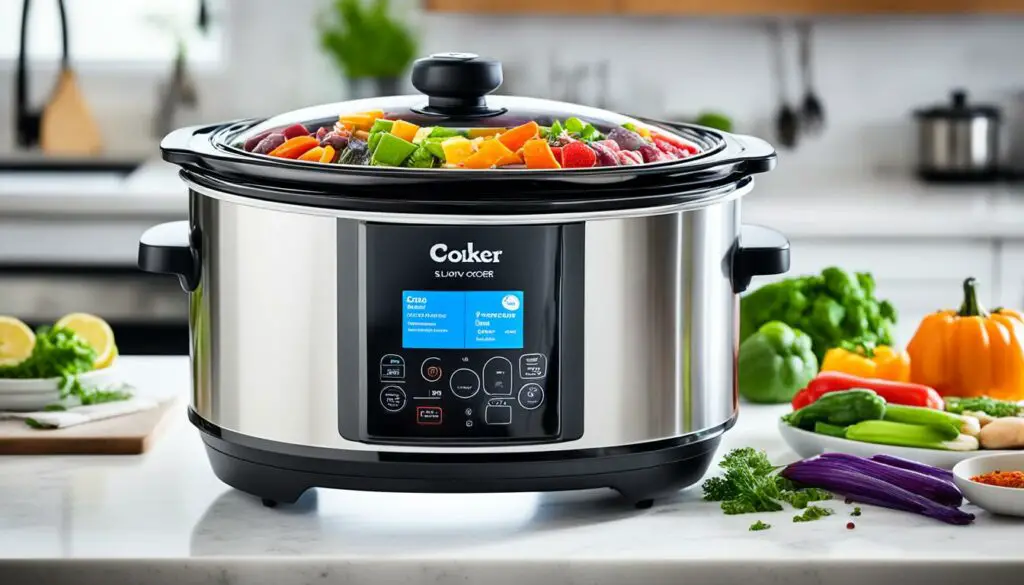
Slow cooker recipes offer incredible versatility, allowing you to create a wide range of delicious dishes with minimal effort. From comforting soups and stews to tender roasts and flavorful casseroles, the possibilities are endless. But did you know that these recipes can also be adapted for cooking on the stovetop?
Whether you want to try a different cooking method or simply don’t have a slow cooker on hand, adapting slow cooker recipes for stovetop cooking opens up a whole new world of culinary possibilities. With a few adjustments and some creativity, you can bring the flavors and convenience of slow cooker dishes to your stovetop.
“The slow cooker may be a popular kitchen appliance, but it’s not the only way to enjoy the flavors of slow-cooked meals. Adapting these recipes for stovetop cooking allows for more control and flexibility in the cooking process.” – [Source]
By adapting slow cooker recipes to the stovetop, you can take advantage of the versatility of the ingredients and cooking techniques. The slow cooking process allows flavors to meld together over time, resulting in rich and vibrant dishes. Adapting these recipes to the stovetop allows you to achieve similar results in a shorter amount of time.
Whether you’re in the mood for a hearty chili, a tender pot roast, or a creamy chicken and rice casserole, slow cooker recipes can be easily adapted for stovetop cooking. Simply adjust the cooking times, heat levels, and techniques to suit your needs.
So why limit yourself to just one cooking method? Embrace the versatility of slow cooker recipes and explore the creative possibilities of adapting them for stovetop cooking. You’ll be amazed at the delicious results you can achieve.
| Slow Cooker Recipe Ideas | Adapted for Stovetop Cooking |
|---|---|
| Beef Stew | Simmer on low heat in a Dutch oven for 2 hours. |
| Chicken Curry | Cook in a large skillet with a lid, stirring occasionally, for 30 minutes. |
| Veggie Chili | Simmer in a stockpot for 1 hour, adding spices and ingredients as desired. |
| Pulled Pork | Cook in a covered skillet with a small amount of liquid for 2-3 hours, until tender and easily shredded. |
As you can see, the adaptability of slow cooker recipes allows you to recreate your favorite dishes using different cooking methods. Whether you choose to slow cook or cook on the stovetop, the flavors and convenience of these recipes remain intact.
So don’t be afraid to experiment and adapt your favorite slow cooker recipes for stovetop cooking. With a little creativity and a few adjustments, you can enjoy the same delicious results in a fraction of the time.
Ready to start adapting your slow cooker recipes for stovetop cooking? Check out this helpful resource on how to convert slow cooker recipes for stovetop cooking for more tips and techniques.
Personal Experiences with Stovetop Adaptation
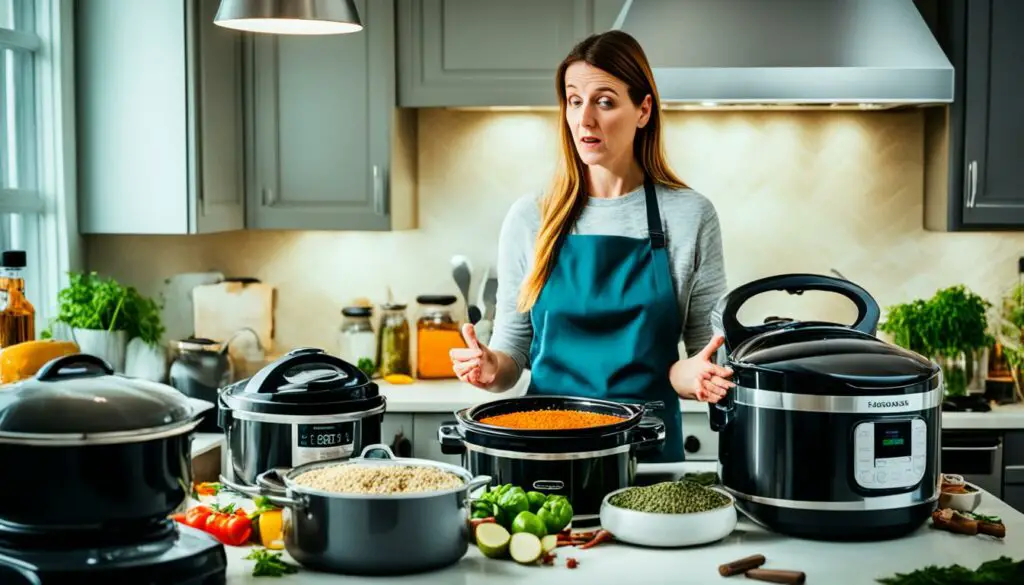
Adapting slow cooker recipes for stovetop cooking is a skill that many home cooks have perfected through personal experiences. These individuals have successfully transformed their favorite slow cooker dishes into delicious stovetop creations. Let’s hear their stories and learn from their insights.
“I recently decided to try adapting my go-to slow cooker chili recipe for stovetop cooking. It was a game-changer! The flavors developed more quickly, and it was ready to serve in half the time. Plus, I loved the control I had over the heat and texture.” – Sarah
For Sarah, the stovetop adaptation of her chili recipe provided a quicker and more customizable cooking experience. The ability to adjust the heat and monitor the texture allowed her to achieve the perfect balance of flavors in less time.
David, another avid home cook, shares his experience with adapting a slow cooker pot roast recipe:
“As much as I love my slow cooker, I really wanted to achieve that caramelized crust on my pot roast. So, I decided to give stovetop adaptation a try. The result? A beautifully seared roast with a rich sauce that coated every bite. It exceeded my expectations!” – David
David’s desire for a caramelized crust led him to experiment with stovetop adaptation. The direct heat allowed him to achieve the desired browning on the roast, enhancing both the flavor and presentation of the dish.
Rebecca, a passionate cook and blogger, discovered the benefits of stovetop adaptation when recreating her favorite slow cooker soup recipe:
“I wanted to share my popular slow cooker chicken noodle soup recipe with a wider audience, but realized not everyone owns a slow cooker. So, I adapted the recipe for stovetop cooking and received rave reviews! It’s amazing how a simple modification can make a recipe accessible to more people.” – Rebecca
Rebecca’s experience highlights the inclusivity of stovetop adaptation. By providing alternative cooking methods, she was able to share her beloved recipe with a broader audience, ensuring everyone could enjoy a comforting bowl of chicken noodle soup.
These personal experiences demonstrate the versatility and satisfaction of stovetop adaptation. Whether it’s achieving quicker cooking times, seared crusts, or making recipes accessible to a wider audience, the stovetop method offers unique advantages that have delighted home cooks across the globe.
Benefits of Stovetop Adaptation
Through personal experiences, home cooks have discovered several benefits of stovetop adaptation:
- Quicker cooking times
- Control over heat and texture
- Caramelized crusts and enhanced flavors
- Access to recipes without a slow cooker
Discover More Slow Cooker Tips and Recipes
Looking for more inspiration and ideas to make the most of your slow cooker? Explore these additional resources and platforms that offer a wide range of slow cooker tips and recipes. From comforting soups to mouthwatering roasts, you’ll find plenty of delicious dishes to try.
1. Slow Cooker Tips
If you’re new to slow cooking or want to enhance your skills, these websites provide valuable tips and tricks for successful slow cooker meals:
- Allrecipes Slow Cooker Section
- Damn Delicious Slow Cooker Recipes
- Delish Healthy Slow Cooker Recipes
2. Slow Cooker Recipe Blogs
These popular blogs are dedicated to sharing incredible slow cooker recipes and meal ideas:
3. Slow Cooker Communities
Connect with a community of slow cooker enthusiasts, share your recipes, and discover new favorites:
4. Slow Cooker Cookbooks
If you prefer browsing through physical cookbooks, consider adding these popular slow cooker cookbooks to your collection:
- “The Complete Slow Cooker” by America’s Test Kitchen
- “Slow Cooker Revolution” by America’s Test Kitchen
- “The Easy 5-Ingredient Slow Cooker Cookbook” by Karen Bellessa Petersen
Remember, slow cooker recipes can be adapted for the stovetop as discussed earlier in this guide. So whether you’re looking for new slow cooker recipes or ways to adapt existing ones, these resources will provide you with endless inspiration and ideas.
Helpful Tools for Stovetop Adaptation
When it comes to successfully adapting slow cooker recipes for stovetop cooking, having the right tools can make all the difference. These tools not only help ensure accurate cooking times and temperatures but also make it easier to record and organize your adapted recipes for future use.
A Reliable Meat Thermometer
An essential tool for stovetop adaptation is a reliable meat thermometer. This kitchen gadget allows you to accurately measure the internal temperature of your dishes, ensuring that they are cooked to perfection. Whether you’re cooking a roast, chicken, or stew, a meat thermometer takes the guesswork out of determining doneness.
Proper Cookware
Using the right cookware is crucial for successful stovetop adaptation. Opt for heavy-bottomed pots and pans that distribute heat evenly, preventing hotspots and ensuring consistent cooking. Choose sizes that accommodate the volume of your adapted recipes, allowing room for ingredients to cook properly without overcrowding the pan.
A Method for Recording Adapted Recipes
As you adapt and experiment with slow cooker recipes on the stovetop, it’s important to have a method for recording your modifications and results. Whether it’s a dedicated recipe notebook, a digital tool, or a recipe app, finding a system that works for you will help you keep track of your adaptations, allowing you to replicate successful dishes and avoid repeating any mistakes.
“Having the right tools on hand not only enhances your stovetop adaptation process but also ensures consistent, delicious results in the kitchen.”
Remember, the helpful tools mentioned above are just a starting point. As you explore stovetop adaptation further, you may discover additional gadgets or utensils that suit your cooking style and preferences. Experiment, take notes, and enjoy the process of recreating your favorite slow cooker recipes on the stovetop.
Conclusion
In conclusion, adapting slow cooker recipes for stovetop cooking is a practical and convenient method for enjoying the flavors and convenience of slow cooker dishes. By following the right techniques and making necessary adjustments, you can achieve delicious results on the stovetop. The process of adapting slow cooker recipes requires discretion, taste testing, and using a meat thermometer to ensure proper cooking.
Experimenting with stovetop adaptation allows you to explore new flavors and enjoy the versatility of cooking with slow cooker recipes in a new way. Don’t be afraid to make modifications and take notes along the way. This way, you can refine and perfect your adaptations to suit your taste preferences and cooking style.
Adapting slow cooker recipes for stovetop cooking not only offers flexibility but also ensures that you can still enjoy your favorite slow cooker dishes even without a slow cooker. Remember to practice safety measures, such as properly defrosting ingredients, monitoring cooking times, and ensuring food reaches the proper temperature to prevent any risks. Embrace the versatility of slow cooker recipes and have fun exploring the world of stovetop adaptations!
FAQ
Can I use slow cooker recipes on the stove?
Yes, you can adapt slow cooker recipes for stovetop cooking. With a few adjustments and techniques, you can recreate the flavors and convenience of slow cooker dishes on the stove.
How do I convert slow cooker recipes to stovetop cooking?
To convert slow cooker recipes to stovetop cooking, you may need to make changes to cooking times, adjust liquid quantities, and alter herb and spice amounts. This guide provides a general conversion method for different types of slow cooker recipes.
What tips can help me successfully adapt slow cooker recipes for the stovetop?
Some tips for successful stovetop adaptation include defrosting ingredients properly, adjusting liquid quantities, altering herbs and spices to taste, and carefully placing ingredients in the pot. Thickening sauces and taking notes for future reference are also helpful.
How do I adjust the cooking time when adapting slow cooker recipes for the stovetop?
Cooking times may vary when adapting slow cooker recipes for stovetop cooking. It’s important to monitor the cooking process carefully and use a meat thermometer to ensure food is cooked thoroughly.
What safety precautions should I take when adapting slow cooker recipes for the stovetop?
When adapting slow cooker recipes for the stovetop, it’s important to handle and cook ingredients safely. This includes defrosting ingredients properly, avoiding pot overflow, using a meat thermometer, and ensuring food reaches the proper temperature to prevent bacterial growth.
What types of recipes can I make in a slow cooker?
Slow cookers are incredibly versatile and can be used to make a wide range of dishes, including soups, stews, roasts, casseroles, and more. They are great for cooking meat to tender perfection and infusing flavors into your dishes.
Are there any personal experiences with stovetop adaptation?
Yes, many individuals have successfully adapted slow cooker recipes for stovetop cooking. They have shared their experiences, challenges, and satisfaction in using the stovetop method to recreate slow cooker dishes.
Where can I find more slow cooker tips and recipes?
There are numerous resources and platforms available that offer a wide range of slow cooker tips and recipes. These include cookbooks, websites, and online communities dedicated to slow cooker cooking.
What tools can assist with stovetop adaptation?
Having the right tools is essential for successful stovetop adaptation. Some helpful tools include a meat thermometer for checking food temperature, proper cookware suitable for stovetop cooking, and a method for recording and organizing adapted recipes.
Is adapting slow cooker recipes for stovetop cooking a practical and convenient method?
Yes, adapting slow cooker recipes for stovetop cooking is a practical and convenient method for enjoying the flavors and ease of slow cooker dishes. With the right techniques and adjustments, you can achieve delicious results on the stovetop.

